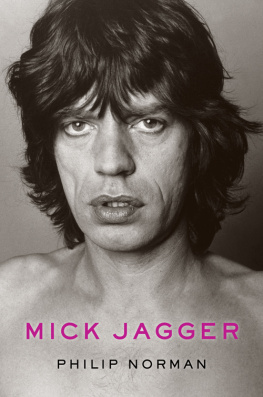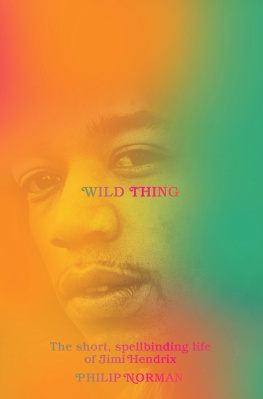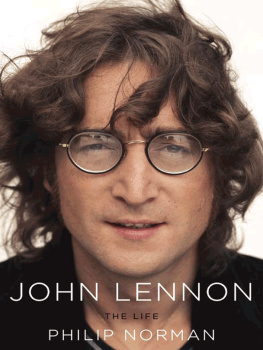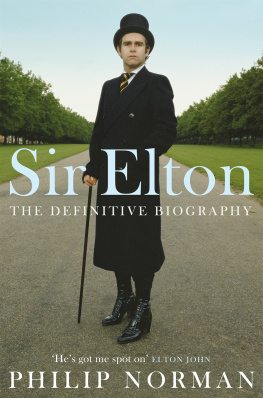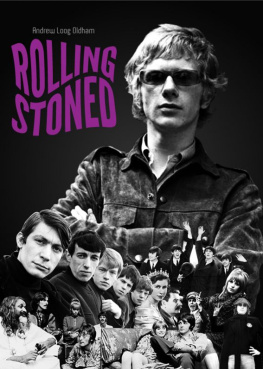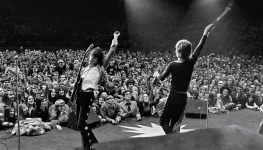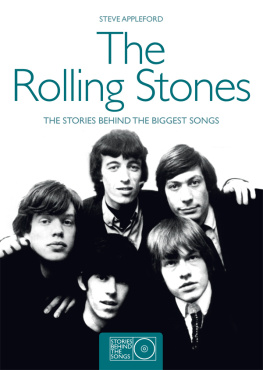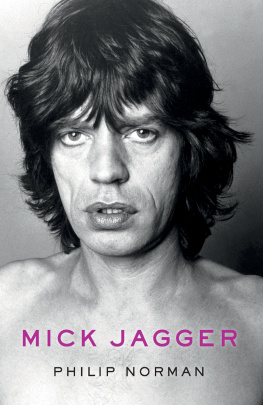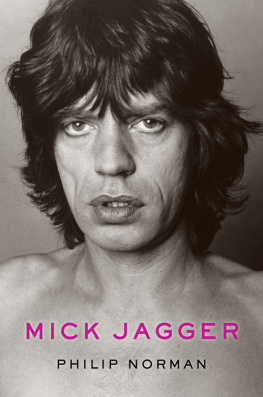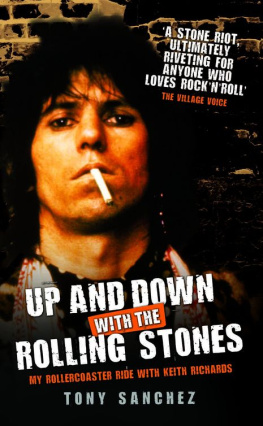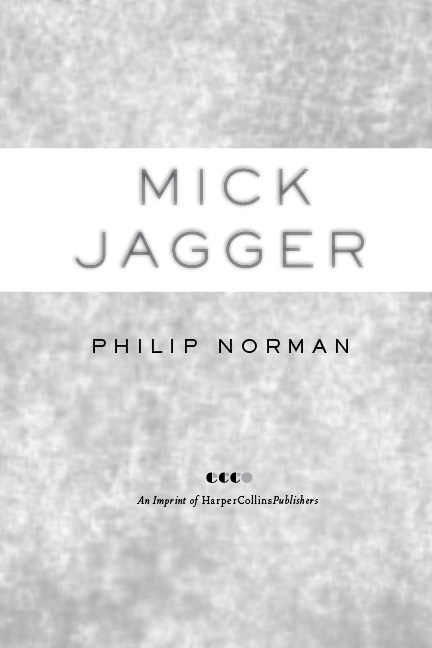
TO SUE, WITH LOVE
Contents
T HE GREAT NINETEENTH-CENTURY painter James McNeill Whistler was once asked how long a certain canvas had taken him to complete. All my life, replied Whistler, meaning the years of training and dedication that had given him his abilities. Likewise, I could be said to have worked on this portrait of Mick Jagger since I first interviewed him, for a small north of England evening newspaper, in 1965. Our conversation took place on the cold back stairs of the ABC cinema, Stockton-on-Tees, where the Stones were appearing in what used to be called a pop package show. Mick wore a white fishermans knit sweater, drank Pepsi-Cola from the bottle and between answering my questions in a not very interested way, made desultory attempts to chat up a young woman somewhere behind me. That one detail, at least, would never change.
In later years, our paths crossed again from time to time, particularly when I was writing about pop music for The Times and Sunday Times of London during the 1970s. But it never occurred to me that I might be collecting material for a future book. There was, for instance, the time I found myself in Rod Stewarts dressing room at the State theater in north London when Mick dropped by after the show. Though he was living apart from Bianca, and clearly at loose ends, that night with Stewart did not turn out as one might have expected. Rocks two greatest Lotharios stood around a piano, chorusing sentimental Cockney songs like My Old Dutch.
I didnt become a conscious Jagger watcher until 1982 when for a Sunday Times article (later the prologue to my Rolling Stones biography) I joined the band on tour in America and was granted my first formal interview with Mick since Stockton-on-Tees in 1965. This time it happened at the Orlando, Florida, Tangerine Bowl while he was doing his customary preshow warm-up on his backstage jogging track. Even before going out to perform to eighty thousand people for two hours, however, the Jagger business brain never switched off. Without pausing in his workout, he told me hed just read my Beatles biography, Shout!, then proceeded to correct a minor point of fact relating to Allen Klein, the manager the Beatles and the Stones used to share. So much for that often repeated claim that he cant remember anything about his astounding career.
It hardly needs saying that this is not an authorized biography. When I accepted the commission in 2009, I made two approaches to the now Sir Mick for cooperation, first privately through a high-level personal friend of his, then publicly through Baz Bamigboyes show-business column in the London Daily Mail . I thought that possibly my credentials as a biographer, most recently of his old friend John Lennon, might at least arouse his curiosity. But when no response came back, I cant say I was surprised. Sir Mick talks to writers only when he has something to sell. And then the palpitating hackfor, female or male, old or young, they all palpitatecan be relied on to churn out the same old clichs. As his one official biographer discovered, he sees no percentage in telling the truth or having it told, even where it reflects most positively on himself. The millions are all in the mythology. And the millions always come first.
So this has had to be a work of investigation and reconstruction, drawing on sources Ive acquired during thirty years of writing about the Stones and the Beatleswho in fact constitute one single, epic story. My thrifty side was tickled to be using the same contacts book in 20092011 that I had for my Stones biography in 19811983. Inevitably, I reviewed the many hours of interview I had all those years ago with Andrew Loog Oldham, Marianne Faithfull, Keith Richards, Bianca Jagger, Anita Pallenberg, Bill Wyman, Ronnie Wood, Paul Jones, Eric Clapton, Robert Fraser, Donald Cammell, Alexis Korner, Giorgio Gomelsky, and others. But, as I did with my John Lennon biography, I promised myself never simply to recycle the group portrait into the solo one. Indeed, it will be seen that Ive revised my view of Mick even more than I did of John.
I must record my indebtedness to Peter Trollope, a superb researcher who opened many doorsnot least on the mystery of Acid King David Snyderman and the sinister background of the Redlands drugs bust of 1967 which put Mick briefly (but still terrifyingly) behind bars. It was through Peter, too, that I made contact with Maggie Abbott, who turned out not only to have been a friend of the elusive Acid King but also Micks film agent in the era when he might have become as big in movies as in rock. Maggie was endlessly helpful and patient, and the section on Micks wooing by Hollywood, and all those missed acting opportunities, would have been thin without her.
Special thanks go to Chrissie Messenger, formerly Shrimpton, and Cleo Sylvestre, whose recollections of the young Mick differ so greatly from the image he was given in his late teens. One great stroke of biographers luck came through Jacqui Graham, whom I first met when she was publicity director at Pan Macmillan publishers and I was one of her authors. Quite by chance, Jackie mentioned that in the early sixties shed been an avid Stones fan and had kept a diarya hilarious one, as it turned outabout following them around their early London gigs, on one occasion doorstepping Mick at home in his pajamas. My other piece of luck was being contacted by Scott Jones, a British filmmaker who has devoted years to investigating Brian Joness death in 1969. Brians mysterious drowning and the Redlands drugs raid both took place in the county of Sussex, and some local police officers were involved in both incidents. Scott generously put me in touch with two of the bobbies who collared Mick and Keith.
My gratitude to Alan Clayson, Martin Elliott, and Andy Neill for fact-checking the manuscript; to Shirley Arnold, who knows better than most that the real Mick has no dark side; to Tony Calder for vignettes of life with Mick and Andrew Oldham; to Maureen OGrady for memories of Mick and Rave! magazine; to Laurence Myers for background to the Stones 1965 Decca deal; to Christopher Gibbs, for guidance as invaluable here as in my Stones book; to Michael Lindsay-Hogg for the backstage story of The Rolling Stones Rock n Roll Circus ; to Sam Cutler for the new perspective on the Altamont festival; to Sandy Lieberson for the saga of Performance ; to Bobby Keys for recalling one hell of a whopper of a good time as the Stones sax player; to Marshall Chess for enlightenment on the Rolling Stones Records and Cocksucker Blues era; to fellow biographer Andrew Morton for insights on Mick and Angelina Jolie; to Dick Cavett, Americas last great talk-show host, for chatting so vividly about being Mick and Biancas next-door neighbor in Montauk; to Michael OMara for his recollections of Micks aborted memoirs; to Gillian Wilson for the observation about Charlie Wattss underwear.
Grateful thanks also to Keith Altham, Mick Avory, Dave Berry, Geoff Bradford, Alan Dow, John Dunbar, Alan Etherington, Matthew Evans, Richard Hattrell, Laurence Isaacson, Peter Jones, Norman Jopling, Judy Lever, Kevin Macdonald, Chris ODell, Linda Porter (formerly Keith), Don Rambridge, Ron Schneider, and Dick Taylor.
Finally, my continuing appreciation goes to my agents and dear friends Michael Sissons in London and Peter Matson in New York; to Dan Halpern at Ecco, New York, Carole Tonkinson at HarperCollins UK, and Tim Rostron at Random House, Canada, for their support and encouragement; to Rachel Mills and Alexandra Cliff at PFD for selling this book in other territories with such enthusiasm; to Louise Connolly for her photo research; to my daughter Jessica for the author photoand so very much more.

